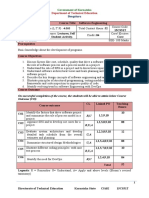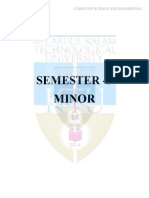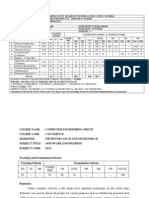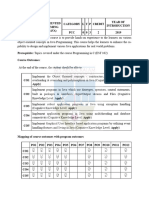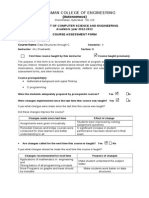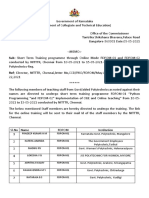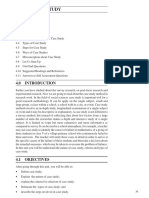Java Syllabus
Uploaded by
KuashalJava Syllabus
Uploaded by
KuashalGovernment of Karnataka
Department of Technical Education
Bengaluru
Course Title: OOP with Java Lab
Total Contact Hours: Course Code:
Scheme (L:T:P) : 0:2:4
78 15CS46P
Type of Course: Tutorial and Credit :03 Core/ Elective:
Practical’s Core
CIE- 25 Marks SEE- 50 Marks
Prerequisites
C Programming Knowledge.
Course Objectives
Learn to write, debug, and document well-structured Java applications.
Course Outcome
On successful completion of the course, the students will be able to attain CO:
Experiment CL Linked Teaching
Course Outcome PO Hrs
linked
CO1 Create and use classes and 1 to 7 30
U, A 2,3,4,8,10
Objects.
CO2
Demonstrate the methods of 8 to 10
String, String Buffer, Vector U, A 2,3,4,8,10 15
and Wrapper Classes.
CO3 Implement interfaces and 11 to 13 15
U, A 2,3,4,8,10
inheritance.
CO4 Demonstrate the use of 14 6
U, A 2,3,4,8,10
packages.
CO5 Implement Multithreading 15 6
U, A 2,3,4,8,10
concepts
CO6
Demonstrate programming 16
techniques with exception 2,3,4,8,10 6
U, A
handling.
Total sessions 78
Legends: R = Remember U= Understand; A= Apply and above levels (Bloom’s revised
taxonomy)
Course-PO Attainment Matrix
Course Programme Outcomes
1 2 3 4 5 6 7 8 9 10
OOP with Java Lab - 3 3 3 - - - 3 - 3
Level 3- Highly Addressed, Level 2-Moderately Addressed, Level 1-Low Addressed.
Method is to relate the level of PO with the number of hours devoted to the COs which address the given PO.
If >40% of classroom sessions addressing a particular PO, it is considered that PO is addressed at Level 3
If 25 to 40% of classroom sessions addressing a particular PO, it is considered that PO is addressed at Level 2
If 5 to 25% of classroom sessions addressing a particular PO, it is considered that PO is addressed at Level 1
If < 5% of classroom sessions addressing a particular PO, it is considered that PO is considered not-addressed.
Directorate Of Technical Education Karnataka State 15CS46P CSE
LIST OF GRADED PRACTICAL EXERCISES
Sl.No Practical/Exercise
1 Write a Java Program to sort a list of names selection sort technique.
Write a Java Program to define a class, describe its constructor, overload the
2
Constructors and instantiate its object.
Write a Java Program to define a class, define instance methods for setting and
3
Retrieving values of instance variables and instantiate its object.
Write a Java Program to define a class, define instance methods and overload them
4
and use them for dynamic method invocation.
5 Write a Java Program to demonstrate use of sub class.
6 Write a Java Program to demonstrate use of nested class.
7 Write a Java Program to implement array of objects.
Write a Java program to practice
8 - using String class and its methods.
- using String Buffer class and its methods.
9 Write a Java Program to implement Vector class and its methods.
10 Write a Java Program to implement Wrapper classes and their methods.
Write a Java Program to implement inheritance and demonstrate use of method
11
overriding.
Write a Java Program to implement multilevel inheritance by applying various
12
access controls to its data members and methods.
Write a program to demonstrate
13 - use of implementing interfaces.
- use of extending interfaces.
Write a Java program to implement the concept of importing classes from user
14
defined package and creating packages.
Write a program to implement the concept of threading.
15 -by extending Thread Class
-by implementing Runnable Interface
Write a program to implement the concept of Exception Handling
16 - using predefined exception.
- by creating user defined exceptions.
Reference
1. Programming with Java, 4th edition, Balagurusamy, Mc Graw Hill, ISBN-
9780070141698
2. Computer Programming in Java, Junaid Khateeb and Dr. G.T. Thampi, Wiley
Dreamtech, ISBN: 9788177228298
Suggested list of student activities
Note: the following activities or similar activities for assessing CIE (IA) for 5 marks (Any
one)
Student activity like mini-project, surveys, quizzes, etc. should be done in group of 2-3
students.
Directorate Of Technical Education Karnataka State 15CS46P CSE
1. Each group should do any one of the following type activity or any other similar
activity related to the course and before conduction, get it approved from concerned
course co-ordinator and programme co-ordinator.
2. Each group should conduct different activity and no repeating should occur.
Some of the topics for mini projects are: S Hotel Management System S E-Bill
Board, Online insurance S Online Mobile Contributor S Online Restaurant S Public
Distribution System S SECURE E-banking security S Service Call Management
S Secure location system S Standard DB EditorS Flight Reservation System S Job
Service Provider S Net Chattering SHospital Management System S E – Shopping
Mall, Personalized web search engine SE-health Care STelecom Linkage System
S Multi Message communication and file sharing system in network S ATM
Database System S Health record System using referral S Online Library
management S Typing text recognition S Online bus ticket booking S Birthday
reminder via Email STime table management system for college S Agriculture
Management System S District medical data center S etc.
Course Delivery
The course will be delivered through Demonstration and Practices
Course Assessment and Evaluation Scheme
When/Where
To (Frequency Max Evidence Course
Method What
whom in the Marks collected outcomes
course)
Two tests
(average of 10 Blue books 1 to 6
two tests)
CIE 10
Record Record
Direct Assessment
(Continuous IA
Internal Student
Evaluation) 05 Report 1 to 6
Students activity
Total 25
SEE
(Semester End End of the Answer scripts
50 1 to 6
End Exam course at BTE
Examination)
1,2,3
Student Feedback on Middle of Feedback
Delivery of
course the course forms
course
Indirect Assessment
1 to 6
Effectiveness
Students of Delivery
End of Course End of the of
Questionnaires
Survey course instructions
&
Assessment
Methods
*CIE – Continuous Internal Evaluation *SEE – Semester End Examination
Directorate Of Technical Education Karnataka State 15CS46P CSE
Note:
1. I.A. test shall be conducted as per SEE scheme of valuation. However obtained marks
shall be reduced to 10 marks. Average marks of two tests shall be rounded off to the next
higher digit.
2. Rubrics to be devised appropriately by the concerned faculty to assess Student activities.
Questions for CIE and SEE will be designed to evaluate the various educational
components (Bloom’s taxonomy) such as:
Sl. No Bloom’s Category %
1 Remembrance 10
2 Understanding 30
3 Application 60
Note to IA verifier: The following documents to be verified by CIE verifier at the end of
semester
1. Blue Book(10 marks)
2. Record (10 marks)
3. Student suggested activities report for 5 marks
4. Student feedback on course regarding Effectiveness of Delivery of instructions &
Assessment Methods.
Directorate Of Technical Education Karnataka State 15CS46P CSE
Format for Student Activity Assessment
DIMENSION Unsatisfactory Developing Satisfactory Good Exemplary Score
1 2 3 4 5
Collection of Does not Collects Collects Collects Collects a 3
data collect any very limited some basic relevant great deal of
information information; information; information;information;
relating to the some relate refer to the concerned all refer to
topic to the topic topic to the topicthe topic
Fulfill team’s Does not Performs Performs Performs allPerforms all 4
roles & duties perform any very little nearly all duties duties of
duties assigned duties duties assigned
to the team team roles
role with
presentation
Shares work Always relies Rarely does Usually Does the Always 3
equally on others to do the assigned does the assigned job does the
the work work; often assigned without assigned
needs work; rarely having to be work
reminding needs reminded. without
reminding having to be
reminded
and on
given time
frame
Listen to Is always Usually Listens, but Listens and Listens and 3
other Team talking; never does most sometimes contributes contributes
mates allows anyone of the talk too to the precisely to
else to speak talking; much relevant the relevant
rarely topic topic and
allows exhibit
others to leadership
speak qualities
TOTAL 13/4=3.25=4
*All student activities should be done in a group of 4-5 students with a team leader.
Directorate Of Technical Education Karnataka State 15CS46P CSE
Scheme of Valuation for End Examination
1 Writing two programs 10+10=20
2 Executing any one program 20
3 Viva Voice 10
Total 50
**Evaluation should be based on the screen output only. No hard copy required.
**Change of question is allowed only once. Marks of 05 should be deducted in the given
question.
Resource requirements for OOP with Java Lab
(For an Intake of 60 Students [3 Batches])
Sl. No. Equipment Quantity
1 PC systems (latest configurations with speakers) 20
2 Laser Printers 01
3 Networking (Structured) with CAT 6e / wireless 03
24 Port switches / Wireless Router
I/O Boxes for networking(as required)
4 Broad Band Connection 01
**Open Source Software should be encouraged
Directorate Of Technical Education Karnataka State 15CS46P CSE
MODEL QUESTION BANK
1 Write a Java Program to sort a list of names selection sort technique.
Write a Java Program to define a class, describe its constructor, overload the
2
Constructors and instantiate its object.
Write a Java Program to define a class, define instance methods for setting and
3
Retrieving values of instance variables and instantiate its object.
Write a Java Program to define a class, define instance methods and overload them and
4
use them for dynamic method invocation.
5 Write a Java Program to demonstrate use of sub class.
6 Write a Java Program to demonstrate use of nested class.
7 Write a Java Program to implement array of objects.
Write a Java program to practice
8 - using String class and its methods.
- using String Buffer class and its methods.
9 Write a Java Program to implement Vector class and its methods.
10 Write a Java Program to implement Wrapper classes and their methods.
Write a Java Program to implement inheritance and demonstrate use of method
11
overriding.
Write a Java Program to implement multilevel inheritance by applying various access
12
controls to its data members and methods.
Write a program to demonstrate
13 - use of implementing interfaces.
- use of extending interfaces.
Write a Java program to implement the concept of importing classes from user defined
14
package and creating packages.
Write a program to implement the concept of threading.
15 -by extending Thread Class
-by implementing Runnable Interface
Write a program to implement the concept of Exception Handling
16 - using predefined exception.
- by creating user defined exceptions.
Directorate Of Technical Education Karnataka State 15CS46P CSE
You might also like
- Alliance University: CSL 406 Course Title: Java Programming LabNo ratings yetAlliance University: CSL 406 Course Title: Java Programming Lab8 pages
- CDP_22AIE111_Object Oriented Programming in JavaNo ratings yetCDP_22AIE111_Object Oriented Programming in Java12 pages
- CSE-2118-Advanced Object Oriented Programming LaboratoryNo ratings yetCSE-2118-Advanced Object Oriented Programming Laboratory4 pages
- Lab Manual Data Structures Using JAVA-R1UC303BNo ratings yetLab Manual Data Structures Using JAVA-R1UC303B33 pages
- Laboratory Manual: Object Oriented Software EngineeringNo ratings yetLaboratory Manual: Object Oriented Software Engineering58 pages
- Ahsan Comple Updated Versition Oops PDF (3) - RemovedNo ratings yetAhsan Comple Updated Versition Oops PDF (3) - Removed42 pages
- 16CS3123-Java Programming Course File-AutonomousNo ratings yet16CS3123-Java Programming Course File-Autonomous122 pages
- Industrial Visit Management System LogbookNo ratings yetIndustrial Visit Management System Logbook11 pages
- Cse R18 Iii-I Se Lab Instruction ManualNo ratings yetCse R18 Iii-I Se Lab Instruction Manual88 pages
- Vardhaman College of Engineering: (Autonomous)No ratings yetVardhaman College of Engineering: (Autonomous)20 pages
- Core Java: Made Simple: A popular language for Android smart phone application, favoured for edge device andFrom EverandCore Java: Made Simple: A popular language for Android smart phone application, favoured for edge device andNo ratings yet
- Punjab Computer Science Online Test 10th Class Chapter 1 Problem SolvingNo ratings yetPunjab Computer Science Online Test 10th Class Chapter 1 Problem Solving6 pages
- 03 BARNHART - The Presentation of Self in Everyday LifeNo ratings yet03 BARNHART - The Presentation of Self in Everyday Life6 pages
- Performance Monitoring and Coaching FormNo ratings yetPerformance Monitoring and Coaching Form2 pages
- Writing An Opinion Column: Part 1 of English ExamNo ratings yetWriting An Opinion Column: Part 1 of English Exam19 pages
- Integrated B.Sc.-M.Sc. (Mathematics) - YearSession - 2023-2024-January-1SEM2023 - REGULAR - Term - 1 - Grade - CardNo ratings yetIntegrated B.Sc.-M.Sc. (Mathematics) - YearSession - 2023-2024-January-1SEM2023 - REGULAR - Term - 1 - Grade - Card1 page
- Processing Requirements For Private SchoolsNo ratings yetProcessing Requirements For Private Schools4 pages
- Introducing The DAP-SPED in Personality Evaluations100% (1)Introducing The DAP-SPED in Personality Evaluations107 pages
- Academic Adjustment and Performance Among Filipino Freshmen College Students in The Health Sciences PDFNo ratings yetAcademic Adjustment and Performance Among Filipino Freshmen College Students in The Health Sciences PDF12 pages
- UT Dallas Syllabus For Aim6334.0g1.11s Taught by Tiffany Bortz (Tabortz)No ratings yetUT Dallas Syllabus For Aim6334.0g1.11s Taught by Tiffany Bortz (Tabortz)9 pages
- Ced-11-501a Mateo, Allanis Mae E. Activity2No ratings yetCed-11-501a Mateo, Allanis Mae E. Activity27 pages
- MGT-351 Human Resource Management Chapter-8 Training and DevelopmentNo ratings yetMGT-351 Human Resource Management Chapter-8 Training and Development28 pages
- Roll No. 125013605: Central Board of Secondary Education, DelhiNo ratings yetRoll No. 125013605: Central Board of Secondary Education, Delhi1 page
- Annexure I Notice: Life Insurance Corporation of India Engagement of Direct Sales ExecutivesNo ratings yetAnnexure I Notice: Life Insurance Corporation of India Engagement of Direct Sales Executives5 pages
- Syllabus On Building & Enhancing New Literacies Across The Curriculum100% (2)Syllabus On Building & Enhancing New Literacies Across The Curriculum8 pages
- Understanding and Applying Assessment in Education -- Damian Murchan; Gerry Shiel -- Sage Publications, Ltd_ (Textbooks), London, 2017 -- SAGE -- 9781473913288 -- 75215a586d79d64e6c66b1ddcc05ad5a -- Anna’s ArchiveNo ratings yetUnderstanding and Applying Assessment in Education -- Damian Murchan; Gerry Shiel -- Sage Publications, Ltd_ (Textbooks), London, 2017 -- SAGE -- 9781473913288 -- 75215a586d79d64e6c66b1ddcc05ad5a -- Anna’s Archive252 pages
- How To Use Isf-Trb & School RequirementsNo ratings yetHow To Use Isf-Trb & School Requirements7 pages

















